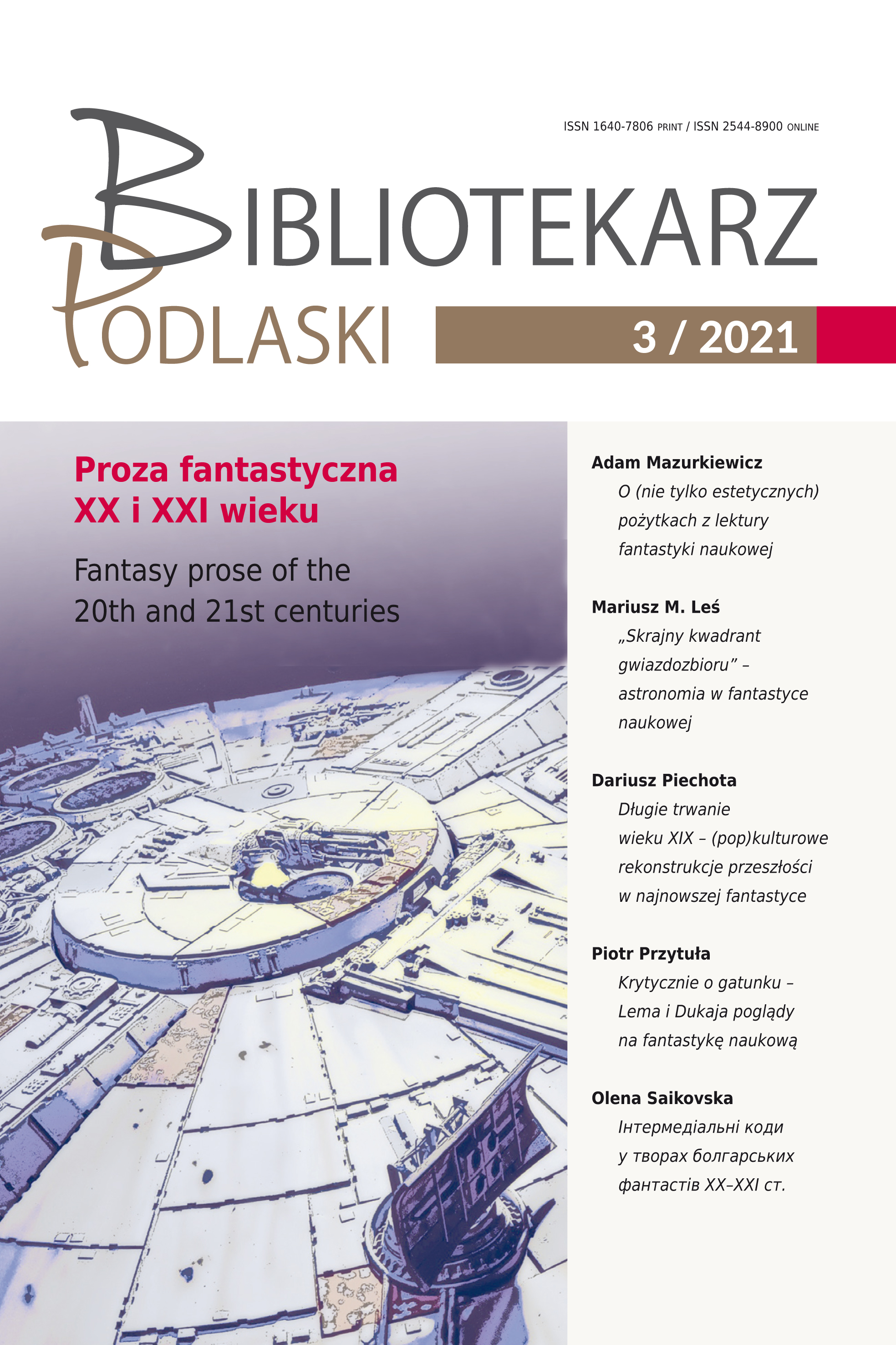Abstract
Stefan Darda’s Dom na Wyrębach [A House in Wyręby] trilogy features the creation of an alternative world full of supernatural beings. Access to it is protected by nature. Wyręby constitutes an opposition (on many levels) to civilised Lublin. The characters arriving at the forest hamlet start to trust their intuition, believing in ghosts, demons and ghouls. In the space created in Wyręby, dreams also play an important role – sometimes they are prophetic, or in other cases they warn of an approaching disaster. The area around Kostrzew is also a place where “everything can start from scratch”, because the world the protagonists collide with forces them to adopt an extremely openminded approach to supernatural phenomena.
References
Aguirre M., Geometria strachu. Wykorzystanie przestrzeni w literaturze gotyckiej, [w:] Wokół gotycyzmów: wyobraźnia – groza – okrucieństwo, red. G. Gazda, A. Izdebska, J. Płuciennik, Kraków 2002.
Baranowski B., W kręgu upiorów i wilkołaków. Demonologia słowiańska, Poznań 2019.
Bobrowski J., Wrona M., Mitologia słowiańska, Olszanica 2021.
Cooper J. C., Sowa, [w:] Zwierzęta symboliczne i mityczne, przeł. A. Kozłowska-Ryś, L. Ryś, Poznań 1998.
Darda S., Dom na Wyrębach, Chorzów, 2016.
Darda S., Nowy dom na Wyrębach, Chorzów, 2017.
Darda S., Nowy dom na Wyrębach II, Chorzów 2018.
Dragan A., Licho nie śpi nawet tam, gdzie diabeł mówi dobranoc. Roztocze oraz wieś Starzyzna jako przestrzenie zła (nie)poskromionego w cyklu powieści grozy „Czarny Wygon”, [w:] Groza w kulturze polskiej, red. R. Dudziński, K. Kowalczyk, J. Płoszaj, Wrocław 2016.
Has-Tokarz A., Kategoria przestrzeni w horrorze, [w:] tejże, Horror w literaturze współczesnej i filmie, Lublin 2010.
Kaczor K., Bogactwo polskich światów fantasy. Od braku nadziei ku eukatastrophe, [w:] Anatomia wyobraźni, red. S. J. Konefał, Gdańsk 2014.
Kubicka H., Tam, gdzie czai się zło. Przestrzeń w horrorze jako mechanizm budzenia strachu, „Literatura i Kultura Popularna” 2010, nr 16.
Linkner T., Słowiańskie bogi i demony. Z rękopisu Bronisława Trentowskiego, Gdańsk 2007.
Linkner T., W romantycznym kręgu słowiańskich wierzeń. Trentowski - Mickiewicz - Słowacki - Kraszewski, Gdańsk 2014.
Olkusz K., Zwierzęta jako monstra we współczesnej fantastyce grozy, „Literatura Ludowa” 2010, nr 4/5.
Olkusz K., Urbanistyka grozy, [w:] tejże, Współczesność w zwierciadle horroru. O najnowszej polskiej fantastyce grozy, Racibórz 2010.
Piechota D., Mroczne opowieści Stefana Dardy z melancholią w tle, [w:] Peregrynacje do źródeł. Lubelski czas zatrzymany. Część IV, red J. Szcześniak, M. GabryśSławińska, Lublin 2014.
Trześniowski D., Magiczne Roztocze, czyli ballady prozą Stefana Dardy (dylogia „czarny wygon”: „Słoneczna dolina” i „Starzyzna”), [w:] Peregrynacje do źródeł. Przestrzeń mityczna, przestrzeń realna Lubelszczyzny w twórczości pisarzy XIX – XXI wieku. Część III, red. J. Szcześniak, D. Trześniowski, Lublin, 2012.
Walc K., Horror, [hasło], [w:] Słownik literatury popularnej, red. T. Żabski, Wrocław 2006.
https://www.literatura.gildia.pl/news/2013/11/nautilus-2013 [dostęp: 29.06.2021]
https://www.literatura.gildia.pl/news/2015/10/nagroda-grabinskiego-2015-przyznana [dostęp: 29.06.2021]
Articles published in the “gold open access” mode on the basis of a non-exclusive license agreement between the publisher and the author. Permitted use:
- the publication may be read and stored on any device,
- the publication may be cited (with obligatory reference to the author, the title of the text, as well as the full title, bibliographic address of the issue and page of the journal)
The editorial team of “Bibliotekarz Podlaski” implements an open access policy by publishing materials in the form of the so-called Gold Open Access. From volume 42 (issue 1/2019), the journal is available under the Creative Commons license (Attribution – ShareAlike: CC BY-SA).
The key declarations of the Open Access and Open Science movement, which we fully support, are available on the CEON Open Science website.
COPYRIGHT:
The editorial team of “Bibliotekarz Podlaski” implements an open access policy by publishing materials in the form of the so-called Gold Open Access. The journal is available under the Creative Commons license – Attribution – ShareAlike 4.0: International: CC BY-SA 4.0).
The key declarations of the Open Access and Open Science movement, which we fully support, are available on the CEON Open Science website.
“Bibliotekarz Podlaski” allows its readers to read, download, copy, distribute, print, search and link to the full content of articles. We enable full, immediate, unlimited (both in a territorial, temporal and technical sense) open access to all published content, in accordance with the principle that freely available research increases and accelerates the global development of science and the exchange of knowledge.
The editorial team of “Bibliotekarz Podlaski” encourages authors to place articles published in the journal in open repositories (after the review or the final version of the publisher), provided that a link to the journal’s website is provided.
The journal does not charge the authors any fees for accepting and publishing their texts.


